Chess
On ice
David Goodman
The 10th Reykjavik International Tour- nament was played from the 9th-21st February in the Kjarvalsstadir, the city's leading art gallery. Unlike previous events, this was organised as a Swiss system with entries limited to Icelanders over 2200 strength and foreigners over 2300. In fact, almost all the foreign players were titled, in- cluding 12 GMs.
The tournament was won, with 8 1/2 points out of a possible 11, by GM Lev Alburt, whose sharp style is well suited to such events. In second place came the relatively unknown Yugoslav player, B. Abramovic, who made his first GM norm. The story goes that Abramovic only learned to play in his early twenties and so has reached his current strength in less than ten years. Three other players almost made GM norms — Gurevich (USA), who missed by half a point, and two young Swedes, Schneider and Wedberg, who both lost in the last round when needing wins.
With a population of only 230,000, Iceland with two GMs and 5 IMs is, in pro- portion to its population, easily the strongest chess country in the world and this was reflected in the interest shown in the tournament and the actual playing con- ditions. The hall was spacious and elegant and crammed full of spectators. Two closed circuit cameras covered the day's play for the benefit of those spectators not in the hall. On the wall were advertisements for Pepsi-Cola and Hitachi, and every evening the TV station carried a short programme about the tournament. Clearly, chess is almost a national pastime in Iceland.
Unfortunately, the organisers were unlucky that their tournament conflicted with other strong events such as those in In- donesia and Argentina, and it is very likely that future Reykjavik opens will become almost mandatory events in the chess calen- dar. Final scores: I Alburt 8 1/2; 2 Abramovic 8; 3 Gurevich 71/2; 4 Byrne, Adorjan, ShaMkOvich and Sigurjonsson 7.
Here is an exciting game from the last round.
Byrne-Schneider: Reykjavik 1982; Sicilian Defence.
1 e4 c5 2 Nf3 Nc6 3 d4 cxd4 4 Nxd4 Nf6 5 Nc3 d6 6 Bg5 e6 7 Qd2 a6 8 0-0-0 Bd7 9 f4 b5 10 Bxf6 gxf6 11 Kbl Qb6 12 Nxc6 Bxc6. Also possible is 12 ... Qxc6 after which White can play 13 a3 followed by g3, Bh3 and f5. 13 f5! An important theoretical novelty. In fact the move had been played once before, in New York, by Popovych, but only because he touched the f-pawn by
mistake. Byrne noticed this game but found a much better plan than Popovych and kept the novelty on ice for more than two years waitulg for an opportunity to play it. 13 ... b4 Needing a win for a GM result, Black accepts the sacrifice. 13 ... 0-0-0 14 fxe6 fxe6 15 Qf4 Bel 16 Qg4 Bd7 17 Bd3 Qc5 18 Ne2 leaves White a tem- po ahead on previous theory. 14 Ne2 Bxe4 15 fxe6 fxe6 16 Nf4 d5 Perhaps Black's best Is 16 b3, e.g. 17 Bd3 bxa2 + 18 Kxa2 Rb8 19 Qc3 Bxd3 20 Rxd3 Kf7 21 Rel Bg7 22 Rxe6 Rhc8. White should therefore try 17 axb3 Qxb3 18 Bd3 Bxd3 19 Nxd3 Qc4 and now after 20 Nf4 or Rel the position is very unclear. 17 Bd3 Qc6 18 Bxe4. dxe4 19 Qe2 Bg7 19 ... h5 fails to 20 Nxh5 Bel 21 Rhfl f5 22 g4! 20 Qg4 Kf7 (Diagram) 21 NO6 Position after 20 . Kf7 h5 22 Qf5 Byrne didn't consider 22 Qx11,4- preferring to maintain his powerful 11 22 ... Rae8 23 Nf4! e3 24 Rd7 + Kg8 If 24 . • Kf8 25 Ng6 + Kg8 26 Ne7 + winning the active R. 25 Nd5 Kf8 26 Rc7 e2 27 Rel Qe6 28 Qg6 Bh 2. 9 Rxe2 Black resigns. A fine win by Byrne, vvh° is well liked in Iceland and is best remembered as Bobby Fischer's second during the world chair' pionship match there in 1972.


































 Previous page
Previous page